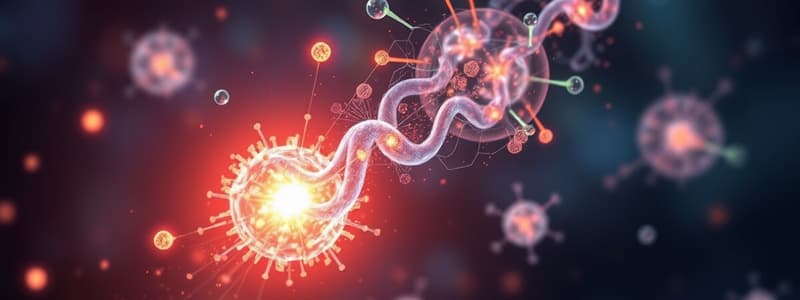Podcast
Questions and Answers
The Gibbs Free Energy of a system is defined as the system's capacity to do work.
The Gibbs Free Energy of a system is defined as the system's capacity to do work.
True (A)
The hydrolysis of _____ is an exergonic reaction that drives many endergonic reactions in a cell.
The hydrolysis of _____ is an exergonic reaction that drives many endergonic reactions in a cell.
ATP
Anabolic pathways of metabolism are pathways that:
Anabolic pathways of metabolism are pathways that:
build complex molecules from simple ones.
Which of the examples are considered anabolism? (Select all that apply)
Which of the examples are considered anabolism? (Select all that apply)
An anabolic reaction decreases entropy within the system because the reaction results in a more ordered macromolecule.
An anabolic reaction decreases entropy within the system because the reaction results in a more ordered macromolecule.
Synthesis of a protein is an example of a chemical reaction that is:
Synthesis of a protein is an example of a chemical reaction that is:
Which of the statements describes catabolic reactions?
Which of the statements describes catabolic reactions?
Flashcards
Gibbs Free Energy definition
Gibbs Free Energy definition
Gibbs Free Energy measures a system's capacity to do work.
ATP hydrolysis
ATP hydrolysis
ATP hydrolysis is an energy-releasing reaction that fuels other reactions in cells.
Anabolic pathways
Anabolic pathways
Anabolic pathways build complex molecules from simpler ones.
Anabolism example
Anabolism example
Signup and view all the flashcards
Anabolic reactions and entropy
Anabolic reactions and entropy
Signup and view all the flashcards
Protein synthesis and reaction type
Protein synthesis and reaction type
Signup and view all the flashcards
Catabolic reactions and free energy
Catabolic reactions and free energy
Signup and view all the flashcards
Study Notes
Gibbs Free Energy
- Gibbs Free Energy indicates a system's capacity to perform work; it is a measure of the energy available from a thermodynamic system.
- True statement: Gibbs Free Energy can drive reactions in a system.
ATP Hydrolysis
- Hydrolysis of ATP is an exergonic reaction that releases energy, which can drive various endergonic reactions within the cell.
Anabolic Pathways
- Anabolic pathways focus on synthesizing complex molecules from simpler ones, contributing to cellular growth and repair.
- Examples of anabolic processes include:
- Growth of fat cells during periods of plenty.
- Synthesis of new DNA copies before cell division.
Entropy and Anabolism
- Anabolic reactions result in decreased entropy in the system due to the formation of more ordered structures, such as macromolecules.
Chemical Reactions in Metabolism
- Protein synthesis represents an endergonic and anabolic chemical reaction, requiring energy input to build complex proteins.
Catabolic Reactions
- Catabolic reactions are characterized as exergonic, meaning they release energy, and exhibit a negative change in free energy, contributing to the overall energy balance in metabolism.
Studying That Suits You
Use AI to generate personalized quizzes and flashcards to suit your learning preferences.

